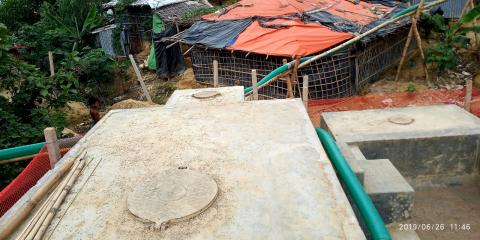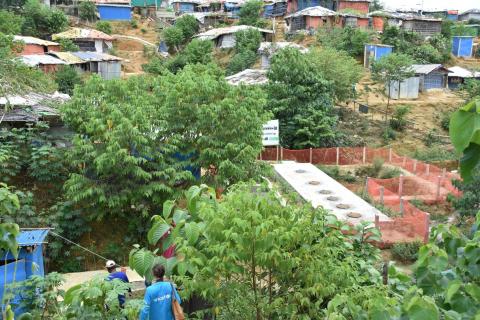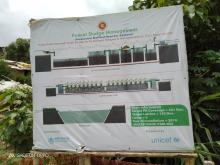Anaerobic Baffled Reactor
Description of the emergency context
Not detailled
Description of the treatment process
The ABR is at the top of the hill and is operated through gravitational force. It consists of settler- thickening tank and 4 baffled reactors. Besides, there is a provision of planted filtration unit using different sizes gravel and sand. The separated liquid part (leachate) of raw FS pre-treated on drying beds further undergone with phytoremediation filtration chamber and followed by a polishing pond. The effluent discharged into the environment within the Bangladesh effluent discharge standards. Canna indica is the perennial plant used in the filtration unit to aid further leachate treatment.
Inside the settler tank, the solid settles down in the ABR and the liquid overflows through a PVC pipe. The liquid goes to the filtration system and after filtering that water, effluent water comes out of the filtration unit and finally in the polishing pond. There is a drying bed for drying purpose of separated solids. These consist of different layers of gravel-sand filter media of different thickness and gavel size. The benefits of these beds include no requirement and use of power. The drying process is enhanced by evaporation and solid-liquid separation by gravity percolation of leachate. There is a scope to use dried sludge as soil conditioner.
Assessment & design (feasibility)
The terrain is a hilly region which has ups and downs but NGOF considered the low lands beneath the hill for the construction of fecal sludge treatment/disposal site. It is protected in such a way that people can’t see the sludge and it restricts the spreading of virus. Raw sludge is untreated non-stabilized sludge, which can be taken from wastewater treatment plants. The details FS characterization of raw sludge was not undertaken during design. The sludge comes from pit latrines and septic tanks. Water is used for anal cleansing. NGO Forum does the desludging through convenes pipe with the help of pumping and maintains proper health safety such as: Mask, Hand Gloves, Gum Boot, Apron, Rake, Convenes Pipe, Octane running Pump, Generator, submersible pump. Besides this, NGO Forum also desludges through transfer stations with the capacity of ten (10) thousand-liter plastic tank using gravitational force. The design was developed based on the secondary information and data. Considered treatment performance of ABRs is in the range of 65% to 90% COD (Chemical Oxygen Demand) removal, corresponding to about 70% to 95% of BOD (Biological Oxygen Demand) removal. The majority of the settleable solids are removed in the sedimentation chamber at the beginning of the ABR, which typically represents 50 % of the total volume of TSS. The special design also allows for an enhanced treatment of non-settleable solids and a Total Suspended Solids (TSS) removal of up to 90% can be achieved. ABRs are a combination of the principles of septic tanks, moving bed reactors and up-flow anaerobic sludge blanket reactors. The majority of settleable solids are removed at the settler and thickening tank in front of the ABR. The inflow is up to 35 m3 per day in this system.
Critical design parameters include a hydraulic retention time (HRT) between 48 to 72 hours, up-flow velocity of the wastewater below 0.6 m/h and the number of up-flow 4 chambers. Vertical baffles in the tank force the pre-settled wastewater to flow under and over the baffles guaranteeing contact between wastewater and faecal sludge and allowing an enhanced anaerobic digestion of suspended and dissolved solids. The connection between the chambers are designed either with vertical pipes with baffles. Accessibility to all chambers (through access ports) is necessary for maintenance. The tank is with cover to allow for control of the ABR system. In addition, provided a biological filtration for treatment of effluent water comes from reactor which enable bacterial colonies to propagate and break down wastes.
Construction
The construction is completed by an experienced external contractor. NGO Forum invites open tender for the proposed work. Then the vendor submits quotation as per the provided quotation. The tender opening committee open the tender box. After the opening committee submits the submitted quotation to the technical committee for the technical evaluation. After the technical evaluation, the technical committee submits it to the purchase committee. Then purchase committee do the financial evaluation based on the experienced and financial responsive vendors. Finally, the work order is issued for the selected work.
The M & E of the construction and installation due emphasis throughout the implementation on FSM interventions to ensure the qualitative aspect of the technologies. A well-experienced and qualified technical team headed by the Technical Expert supervised and provided overall guidance to the Project Engineer and Assistant Project Engineer in relation to technical aspects. A major portion of the outputs have been accomplished with the direct involvement of the technical team having wide experience in drawing, designing, construction and installation FSM infrastructure. Access and legal permission is needed for taking the materials and Land identification and purchase/rent (procedure, involved institutions, legal framework, challenges). Security and safeness during construction/installation was needed (type of PPE, specific rules, responsibilities, challenges).
NGO Forum use the internal expert and sector standard for upgrading or decommission of the FSM. In few cases NGO Forum has hired external contractor. NGO Forum follows the sector standard and guidelines for upgrade. NGO Forum has few resources such as clean/filtering grabbles, clean the safety tank chamber, cleaning the inlet pipe and increase the level of mud for creating dike. Enough Water, local vehicles for transporting in the hilly area through a necessary community consultation as well as permission from the Camp In Charge (CIC) and Site Management Service (SMS) are necessary for upgrade/decommissioning. Mask, Hand Gloves, Gum Boot, Apron and Rake is used as PPE. We normally follow the standard rules for using PPE. Every dislodging volunteer is responsible for completing the task. And over them there is Assistant Engineer and CHP for the monitoring. One of the challenge is for ensuring the quality our Project Engineer has to supervise directly.
Operation and maintenance
Desludging team are involved for emptying and transportation. NGO Forum used the equipment’s like octane operated pump, convenes pipe, 2-inch PVC pipe, Hoss pipe, Jubilee/lock Clip, bucket, mask, hand gloves, gum boot, apron, rake and materials like alum, lime and bleaching powder. There is 85% of BOD reduction. Mask, hand gloves, gum boot, apron and rake is used as PPE. NGO Forum normally followed the standard rules for using PPE. Every dislodging volunteer is responsible for completing the task. And over them there is an Assistant Engineer and Community Hygiene Promoter (CHP) for the monitoring. Washing facilities are available. The site is protected by a fence and drainage is implemented. End products are used as soil conditioner. There is scope to use in gardening. Maintaining the retention period on the treatment is a challenge.
Lessons learned
If we construct small sewerage borehole and increase secondary transfer station, safety tank then the cost will be reduced. By constructing small sewerage borehole or transfer station, we can reduce contacts between staff and sludge. Ensuring community engagement and engaging skilled volunteer’s can guarantee the sustainability of the plant.
Specific challenges:
• emptying frequency too high as a result it is difficult to maintain retention periods.
• leakage of convenes pipe
• quality of effluent water
• space in the camps is limited due to the number of people and topography
• landslides in the rainy season
Strengths
It is a safely managed FSM system with biological treatment and environment friendly. There is scope to create the opportunity from this where community people are economically benefited.




Add new comment